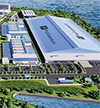Front Line: Satisfying the Semiconductor Industry’s Workforce Needs
As the semiconductor industry announces plans to grow domestic production, it is facing a workforce shortage.
Q3 2023

The announcement came at a crucial time for the U.S. semiconductor industry. In August 2022, President Biden signed into law the CHIPS and Science Act, which will provide about $280 billion in new funding over the next decade to help grow domestic research and manufacturing of semiconductors.
A number of chipmakers have responded by announcing plans to build new plants. Along with the Arizona plant, those include Samsung’s plans for a $17 billion facility near Austin, Texas, and Intel’s groundbreaking for the first of two large fabrication plants worth $20 billion in Ohio. Intel is one of the few companies producing all of its silicon chips in the U.S.
Right now, the industry’s biggest problem may be finding enough skilled engineers and technicians to staff those plants. As U.S. manufacturers’ share of the world’s computer chips has dropped to just 12 percent, educational programs have followed a similar direction. But efforts to power up the labor supply have been ramping up, nationally. Universities and colleges have been updating their semiconductor-related curricula and forming partnerships with industry and other educators to remedy the shortfall.
Universities as Part of the Solution
There were around 20,000 job openings in the semiconductor industry at the end of 2022, according to Peter Bermel, an electrical and computer engineering professor at Purdue University. “The workforce needs of the semiconductor industry are going to evolve quite quickly, with the industry just beginning to be aware of the future needs, and developing students,” Bermel says. “Universities have to be part of the solution; a lot of workers need specialized (industry) knowledge. Even trade schools and community colleges need support and guidance from research universities, which is why we’re working with them on workforce development.”
Bermel says there is a developing cluster near Purdue of companies involved in the semiconductor industry and those that use them in their products. He notes that the rapidly developing artificial intelligence sector “will heavily impact the semiconductor labor market, and drive labor toward less absolute number of workers, but better-educated workers who understand the big picture and understand all of the different parts” of manufacturing processes.
There were around 20,000 job openings in the semiconductor industry at the end of 2022. Bermel is director of the Scalable Asymmetric Lifecycle Engagement Microelectronics Workforce Development program (SCALE), a $19.2 million multi-university public/private/academic partnership intended to foster work force development across engineering universities in the U.S. It includes a partnership of 19 universities, 17 government agencies, and 31 industrial defense-based companies to ensure that workforce needs are being met.
One of the companies partnering with Purdue is Minneapolis-based SkyWater Technology. Sara Johnson, director of talent acquisition for SkyWater, says the company also has training partnerships with several other universities and technical schools, including the University of Minnesota College of Science and Engineering and the University of Central Florida.
“We’re working on reviewing curriculum,” to make sure it is current and relevant to developing scientific knowledge, she says. “We hire a lot of graduates from the U of M material science and chemical engineering program, and we partner locally with technical schools. There is a great need for technical talent within equipment and facilities maintenance,” she adds.
According to Johnson, SkyWater, founded in 2017, continues to see rapid growth in its custom chip manufacturing business and is approaching 800 employees in the Minneapolis area, and another 60 at its Florida location. It currently has about 85 unfilled positions, from entry-level to leadership levels.
“The fact is that, in order for the industry to thrive, we are going to need about 250,000 new employees in the next five years, including about 50,000 engineers,” Johnson says.
Meeting that need will require a “holistic” approach, she says, and create programs focused on K–12, all the way up to university and post-graduate individuals.
SkyWater offers “immersive” learning experience to high school and college-level interns. It also partners with organizations that help veterans make the transition out of the military.
Project Announcements
Shapeways Holdings Expands Livonia, Michigan, Operations Complex
07/07/2023
Germany-Based Becker Robotic Equipment Plans Canton, Georgia, Manufacturing Complex
12/07/2022
LEGO Group Plans Chesterfield County, Virginia, Manufacturing Plant
06/17/2022
Scotland-Based PowerPhotonic Plans Sahuarita, Arizona, U.S. Headquarters-Production Campus
04/04/2022
A. Duie Pyle Plans Manassas-Richmond-Roanoke, Virginia, Cross Dock Service Centers
03/15/2022
Black Buffalo 3D Corporation Relocates-Plans Smithfield Township, Pennsylvania, Manufacturing Complex
02/07/2022
Most Read
-
The Workforce Bottleneck in America’s Manufacturing Revival
Q4 2025
-
Rethinking Local Governments Through Consolidation and Choice
Q3 2025
-
Lead with Facts, Land the Deal
Q3 2025
-
Investors Seek Shelter in Food-Focused Real Estate
Q3 2025
-
Tariff Shockwaves Hit the Industrial Sector
Q4 2025
-
America’s Aerospace Reboot
Q3 2025
-
The Permit Puzzle and the Path to Groundbreaking
Q3 2025


